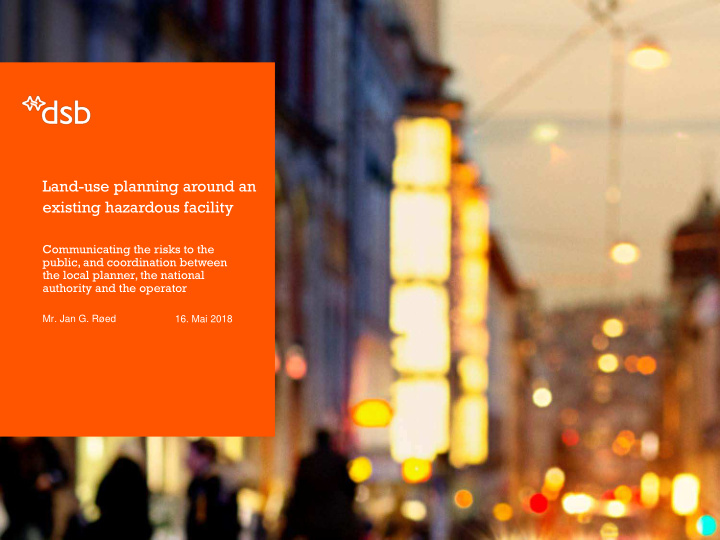



Land-use planning around an existing hazardous facility Communicating the risks to the public, and coordination between the local planner, the national authority and the operator Mr. Jan G. Røed 16. Mai 2018
Revision of the land- use plan for the city of Sarpsborg - - where an existing major hazard site is situated
Revision of the land-use plan for the city of Sarpsborg – a challenge due to: • An existing major hazard site : the production process at the Borregaard cellulose factory utilize large amounts of sulphur dioxide, which implies the risk of dispersion of toxic gas into urban areas surrounding the factory. • Requirement of new consideration zones in existing dwelling areas, and how to communicate the associated risk to the population: “The activities at the factory are safer than ever, but the society safety requirements are increasing..”
Intentions in the new land-use plan: • Urban development • Condensing of the residential areas (from low-rise buildings to block of flats) • Growth in population in the city by 40 % next decade • Implementation of new consideration zones in existing residential areas
Norwegian regulations and responsibilities Norway have some general regulations to provide that the safety of public is considered around hazardous installations. • The Planning and Building Act (and regulations) – Takes care of issues concerning the land-use planning – The local authorities are responsible • The Fire and Explosion Prevention Act (and regulations) – Takes care of the site risks through consents etc. – DSB is responsible • The two acts are the legal framework for the national policy on siting of major hazard installations, as set up in the UNECE Industrial Accident Convention, Article 7 Decision-making on siting . • However, Norway do not have any hazardous activities with transboundary effects.
Consideration zones DSB has introduced a system for zoning based on the establishment of criteria for acceptable risk (report) , which gives the extent of three zones (based on individual risk contours), with directions for developments in the zones: Inner zone: the major hazard site own area – only short term passing of third party population Middle Zone: public road, railway, quay, etc. and regular workplaces are allowed. No housing or other kinds of overnight stay. Outer Zone: Residential areas and areas for ordinary public use (shops, smaller hotels etc.) Outside Outer Zone: Schools, kindergartens, hospitals, nursing homes, large malls, hotels, concert and sport arenas. 7
Guidance on the LUP around major hazard sites Three types of issues or processes are particularly highlighted in the guidelines: 1. Maintain proper distance to the population around major hazard sites 2. New developments (changes) in the surroundings of major hazard sites 3. The establishment of new sites and major modifications in existing major hazard sites.
Guidelines on quantitative risk analyses for facilities handling hazardous substances • Guidelines developed by Lloyds Register for DSB • Directions (primary) on individual risk contours • The main objectives of the guidelines are to reduce casual variation in the results (contours) due to data basis and methods 9
Back to the case: Revision of a land-use plan Main measures/activities related to new consideration zones: 1. Temporary building ban (april 2016) 2. Calculation of risk contours (july 2016) 3. Preparation of an overall risk and vulnerability assessment for the areas covered by the land-use plan (2016/2017) 4. Proposal for new consideration zones (april 2017) 5. Public hearing of the revised land-use plan (2018 on-going)
1. Temporary building ban
2: Calculation of risk contours • QRA by DNV GL for the major hazard site of Borregaard cellulose factory • Calculation of individual risk contours as a basis for determination of the consideration zones in the land-use plan 12
3: Preparation of an overall risk and vulnerability assessment • As a part of any land-use planning process civil protection shall be reviewed in a risk and vulnerability assessment • Industrial hazards is on of the topics to be assessed in addition to natural hazards, as a “all hazard approach” • The calculated individual risk contours was adopted by the risk and vulnerability assessment, as a basis for determining the extent of the considerations zones
4: Proposal for new consideration zones • A public meeting was arranged by the local planning authority in cooperation with the operator and DSB, as the competent authority • The atmosphere at the meeting was quite aggressive, due to a foreseen: – loss of private real estate economic values – loss of possibilities for real estate developments – lack of future incentives for urban development and embellishment of the area in general
5: Hearing process • The consideration zones (on hearing) have been prepared closely linked to DSB's guidelines • A public meeting dedicated to the topic of major accident consideration zones was arranged again during the hearing process • The final consideration zones will be decided as a part of the land-use plan, witch will undergo a local political decision
Summary of our experiences • Transparent public information about dangers and the necessity of the measures to be taken (the consideration zones). • Early information of the planned restrictions and the opportunity for the public to query and comment • The message (to the public) from the three parties (the local authority, the operator and the competent authority) should be identical (more or less) and based on a good dialogue • Take benefits of the formal land-use planning process and the associated requirements for public information and involvement. • Use time on the LUP process. Recognition of the restrictions needs time to adopt, including other positive aspects – e.g. (in this case) prevention of tower blocks in the neighborhood.
Recommend
More recommend